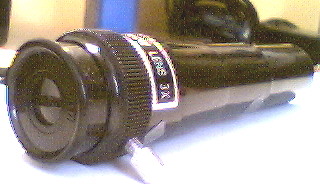This review is intended to help first-time buyers who are considering a telescope. The Bushnell range are common throughout shopping arcades, science and nature stores and as such get much visibility to the public. However despite reading dozens of web pages, some astronomy mags and a couple of news groups, the only comments on this brand, let alone this model, were rubbish, don't bother, etc. and with no real explanations to back up their claims.
However, if, as myself, you approached this subject for the first time, the one thing that I can't really overstate is that to most people money is the most important criteria. Being of a severely limited budget I wanted something to try that wasn't too expensive. I accepted that you cannot get quality at the cheap end of the market, but what exactly can you get for around £100? If you are never going to use it more than once then this is expensive, however if it turns out to be the first step on a life long interest then the cost is very low.
Basics - body
The main tube is very thin metal with a silver-grey finish. This is obviously rolled from a single sheet since it has a large seam on the underside running along the full length. The ends have black plastic trims. It is very light (~0.75 kg) and feels reasonably strong, showing no signs of flexing in normal usage or when removing from the mount. However the metal is so thin that any reasonable knock would certainly dent it.
A usable manual was sadly lacking - just an A4 sheet with a bad diagram. Considering that a first-time user probably knows nothing about reflectors, an exploded construction guide wouldn't hurt, plus simple instructions on setting up the tracking scope for instance, would help.
|
|
|
|
The Mount
The tripod is made of three sliding wooden legs and although cheap, makes a reasonably solid base with the accessory tray tied in and at full spread. However the weight is only of the order of 1 kg and won't stand up to a blustery evening without wobbling. Also with no feet on the legs the tripod has a tendency to walk (one leg flexes if you touch it and the other two spring out a bit) or slide when on concrete. The mount cannot actually be separated from the tripod which is annoying. However it is possible to lift the whole tube straight out of the sockets if you need to.

The main problem is the fixing method to the body itself. Rather than having a yoke (two bands completely around the tube with a bottom strip), as does every other reflector of this style, it has two 'ears' which stick out on either side of the tube. These then sit in the sockets of the u-shaped mount. This arrangement means that as the tube is tilted up and down the ears walk up and down the sockets on the u-mount. These sockets do come with a washer set, but this has no effect and actually makes the movement more jerky, so I removed them. It is thus possible for the tube to walk out completely I suppose, but I have never personally seen this happen in practice. Due to the bad placement of the ears, they do not sit exactly opposite each other on either side of the tube which causes more uneven movement. Finally due to the bad fixing of the ears (only attached by two crosshead screws) the tube can tilt a couple of degrees without moving the ears - so as soon as you let go the tube drops back those couple of degrees. This causes you to constantly over-compensate for the vertical movement to allow it to settle back to where you want it. This is extremely annoying and causes navigation to become quite a black art even at low magnifications (x4).
There is no hope of fixing a motor to this arrangement - and nor would you want to. I should point out that the kit comes with a stabilizing bar, supposedly with a fine movement adjuster. In practice this is just a nuisance and adds no stability to the mount. The fine adjustment can do little if the whole tube can wobble by a couple of degrees!
Optics
The main focuser gives smooth and even travel, so focusing itself has no problems. The kit comes with a 20mm eyepiece, a 4mm eyepiece and a 3x Barlow lens which are all 0.965" diameter. The focuser also comes with a 1.25" fitting collar if you already have any 1.25" eyepieces - although unscrewing the old 0.965" collar requires considerable force and patience.
The 20mm eyepiece is a good cheap workhorse and can give good images of the Moon, Jupiter's moon and just about a ring on Saturn with good conditions. No noticeable colour aberration (to my untrained eye). However, that is where it stops. The 4mm eyepiece is dreadful. It is almost impossible to get anything approaching a clear image with this, so even medium magnifications are out (the 525x on the box is complete rubbish - 50x per inch aperture seems a good guide). The Barlow is also of poor quality but used with the 20mm can give larger Jupiter pictures if less well resolved. The combination of the Barlow and 4mm is a joke - you cannot get passed the airy rings let alone into focus.
|
|
|
|
Conclusion
Irish man's directions: "Oh, if I was going there, then I wouldn't start from here"
The bottom line is that the telescope is very poor quality. Having bought one I can now see that the extra £70 to buy a cheap Helio or Tal is well worth the money.





